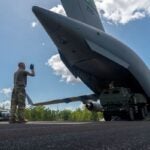
NATIONAL HARBOR, Md.—The Air Force believes virtual constructive and live training is more important than ever due to decreased budgets and aircraft, so the head of the service’s Air Education and Training Command (AETC) is focusing on getting state-of-the-art capability into the fleet.AETC chief Lt. Gen. Darryl Roberson said Sept. 15 fidelity of simulation and ground-based training environments is one of the key parameters the service is looking for in next-generation training and simulation. Fidelity, Roberson told reporters at the…













